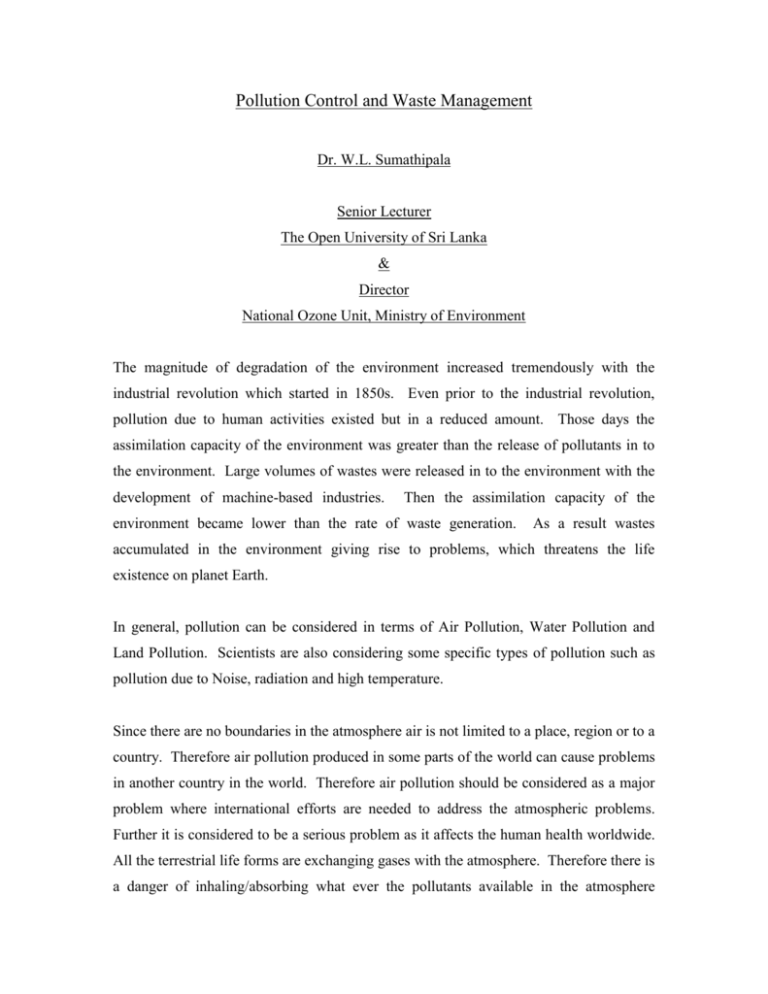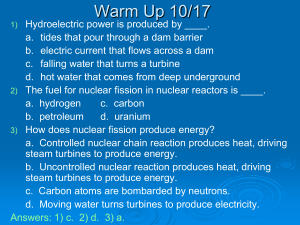Pollution Control Symposium theme talk 20
advertisement

Pollution Control and Waste Management Dr. W.L. Sumathipala Senior Lecturer The Open University of Sri Lanka & Director National Ozone Unit, Ministry of Environment The magnitude of degradation of the environment increased tremendously with the industrial revolution which started in 1850s. Even prior to the industrial revolution, pollution due to human activities existed but in a reduced amount. Those days the assimilation capacity of the environment was greater than the release of pollutants in to the environment. Large volumes of wastes were released in to the environment with the development of machine-based industries. Then the assimilation capacity of the environment became lower than the rate of waste generation. As a result wastes accumulated in the environment giving rise to problems, which threatens the life existence on planet Earth. In general, pollution can be considered in terms of Air Pollution, Water Pollution and Land Pollution. Scientists are also considering some specific types of pollution such as pollution due to Noise, radiation and high temperature. Since there are no boundaries in the atmosphere air is not limited to a place, region or to a country. Therefore air pollution produced in some parts of the world can cause problems in another country in the world. Therefore air pollution should be considered as a major problem where international efforts are needed to address the atmospheric problems. Further it is considered to be a serious problem as it affects the human health worldwide. All the terrestrial life forms are exchanging gases with the atmosphere. Therefore there is a danger of inhaling/absorbing what ever the pollutants available in the atmosphere because they do not have a filtering mechanism. On the other hand the pollutants released in to the atmosphere gets diluted and the possibility of collecting or treating such pollution is impossible. Therefore preventing, controlling or treating these substances before releasing them in to the atmosphere is very important. The atmospheric lifetime of some pollutants/chemicals is very high and they cause global environmental problems such as Ozone Layer depletion. The main sources for air pollution are burning fossil fuels for energy generation & transportation, biomass burning and industrial emissions. The sources of air pollution give rise to gases, mixtures of fine particles or both. Most common gases generated from burning fossil fuels are CO2, CO, Oxides of Nitrogen, Oxides of Sulfur and unburned hydrocarbons. Pollution due to biomass burning for cooking is very common in the Asian region. This will generate unburned hydrocarbons due to incomplete burning processes, mixture of oxides of carbon, nitrogen & sulfur and particulate matter. Industrial emissions are responsible for most hazardous chemicals such as fluorinated carbons, PFCs, SF6, etc. Considering the difficulty of treating these gasses after releasing in to the atmosphere it is important to either control or treat the emission before releasing to the atmosphere. In the industrial sector, controlling the emission of air pollutants can be achieved through changing the method of plant operation, changing the input or raw materials used in the process, adopting cleaner production methods or treating the pollutants prior to release. Gaseous pollutants can be removed from their gaseous environment to either a liquid or a solid surface, where they will be preferentially retained, or where they react to form a non polluted species. There are processes with various methods used for collecting gases with high concentration such as absorption in to a liquid or solid or adsorption on to a solid surface. These are occurring either with or with out reaction. Pollutants generated due to incomplete combustion can be removed through complete combustion converting them into CO2 and water. This can be achieved in a combustion chamber providing sufficient air in the presence of a catalyst. In order to prevent the release of particulate matter to the atmosphere, settling chambers, gravity separators, cyclone dust collectors, filters, wet scrubbers and electro statistic precipitators can be utilized. Emission of radioactive particles is possible due to the development of energy generation through nuclear power plants. Since these materials cannot be detected by human senses such as taste or smell and even a very minute quantity is lethal, there has to be stringent regulations utmost in operating these plants and handling waste. These should operate on hundred percent accident free environments. In addition, installation of multiple barriers, real time monitoring and error free safeguard systems are very important for these facilities. Indoor air quality is very important, mainly because people remain indoors in excess of 90% of their lifetime. Common indoor pollutants are Paints, Varnish, polish, household polymers, fuel wood burning, burning incense sticks and mosquito coils. Houses or buildings with less ventilation are vulnerable for indoor air pollution resulting in nausea, vomiting, dizziness and respiratory diseases. As a solution, Architects can design wellventilated buildings with more air circulation. Substances such as CFC, Halons, CTC, HCFC are depleting the Ozone Layer that protects human from the Sun’s dangerous UV radiation. Increase of Greenhouse gases such as Fluorinated Carbons, Methane, and Nitrous Oxides in the atmosphere is making the earth atmosphere warmer resulting in climate change and sea level rise. Global commitment is essential in order to control such global environmental problems. Montreal Protocol and Kyoto Protocols are major global agreements to take action in order to control these two major environmental problems. Water is a basic requirement for sustaining life. Out of the total volume of available water in the planet, less than 1% is suitable for human consumption. This limited resource is further reduced due to human activities, which make it unusable. Main sources of water pollution are release of industrial waste, dumping solid waste, sewage, human waste including faecal matter, sediment run off due to soil erosion etc. As a result of such activities, concentration of dissolved carbons, heavy metals, biohazards such as bacteria and virus and other nutrients will increase in the water sources resulting in loss of biodiversity and making the water unsafe for consumption. Several methods have been developed for water treatment once it is polluted. Biological treatment, chemical coagulation and filtration, carbon adsorption, chemical oxidation, ion exchange, electrodialysis, reverse osmosis, air stripping are some of them. Water bodies are also being polluted due to discharge of sewage from watercrafts and oil spilling around the world. Designing holding tanks for receiving and storing sewage until they can be unloaded on the shore is one controlling method. Large vessels can be equipped with biological treatment plants. Leaks from offshore drilling and accidental oil spills are possible resulting in threat to water creatures and large-scale killing of sea birds. Surrounding the oil slick with a mechanical barrier until it can be removed, collecting the oil by mechanical means such as suction pumping or absorption by a suitable material and dispersing the slick with chemicals are methods practiced today. Environmental problems due to solid waste are a growing problem in Sri Lanka and it is a major problem in many of the developing countries. Current rate of waste collection by the local authorities in Sri Lanka is estimated to be about 2,500 tones per day. Rate of waste generation depends on a number of factors such as socio economic conditions, public attitude towards reuse and recycling of waste and geographical and physical factors. Due to the improvement of technology, a tremendous increase in non-degradable packaging materials such as plastic, polythene, metals and glass can be seen. Solid wastes are generated from domestic, institutional, market, medical, commercial, industrial and garden sources. Industries such as food, paper, cardboard, rubber, and leather are good sources of organic waste. A greater portion of commercial and domestic waste are organic and biodegradable. The major problem in relation to solid waste is uncontrolled disposal of wastes. Toxic and hazardous wastes are generated mainly from industrial and medical sectors. The extent of land pollution increases due to unorganized solid waste disposal practices. Developing facilities for safe disposal and management of solid waste should be a high priority in society. With the rapid development, population growth and urbanization, solid waste has increased and therefore it is essential to manage solid waste. There is also a serious threat of utilizing Sri Lanka as a hazardous waste dumping site. According to the estimates the local authorities collect only a part of the waste generated. Disposing wastes in the home gardens are common in rural areas due to lack of collecting system or facilities. At present waste disposal is mainly in open dumps, which are unsanitary. Most of these areas are low laying marshy lands and abandoned paddy fields. As a result leachate, emission of gases, odors, fire and loss of aesthetic beauty are possible. As an alternative to open dumping, sanitary land filling has to be introduced. Proper planning is essential to minimize the side effects. Separation of solid waste at the point of generation is essential and thereafter different categories can be treated separately. Biodegradable materials have to be composed and used as organic manure as far as possible. Avenues for collecting recyclable materials and recycling should be promoted. The final waste that is not possible for recycle has to be dump in a sanitary landfill. Incineration is another option but the capital cost is very high and therefore it may not be suitable for a developing country. At least several small-scale incinerators are essential to destroy toxic and hazardous waste. Noise pollution has a very close relationship with occupational safety. In most cases industries are responsible for high noise pollution. Recent studies show that there is direct relationship with high levels of noise and mental health. Noise management can be achieved at the point of its origin and along the noise pathway and at the point of reception. There are several noise management techniques available at present. Shock absorbing techniques, use of non metal parts to reduce the noise generated, use of acoustic guards, installing machinery on adequate mountings, locating machinery away from the residential areas are some of precautionary methods. In most of the industries a large amount of heat is generated and released in to the atmosphere. This problem of thermal pollution can be alleviated by using artificial cooling ponds or cooling towers. Where possible this high temperature can be utilized for useful work such as generation of electricity. In order to control pollution, proper and appropriate legislation, emission and effluent standards for industries are essential. Awareness creation among the general public and making the man more environment friendly is an over all approach for environment protection. Thank you,








